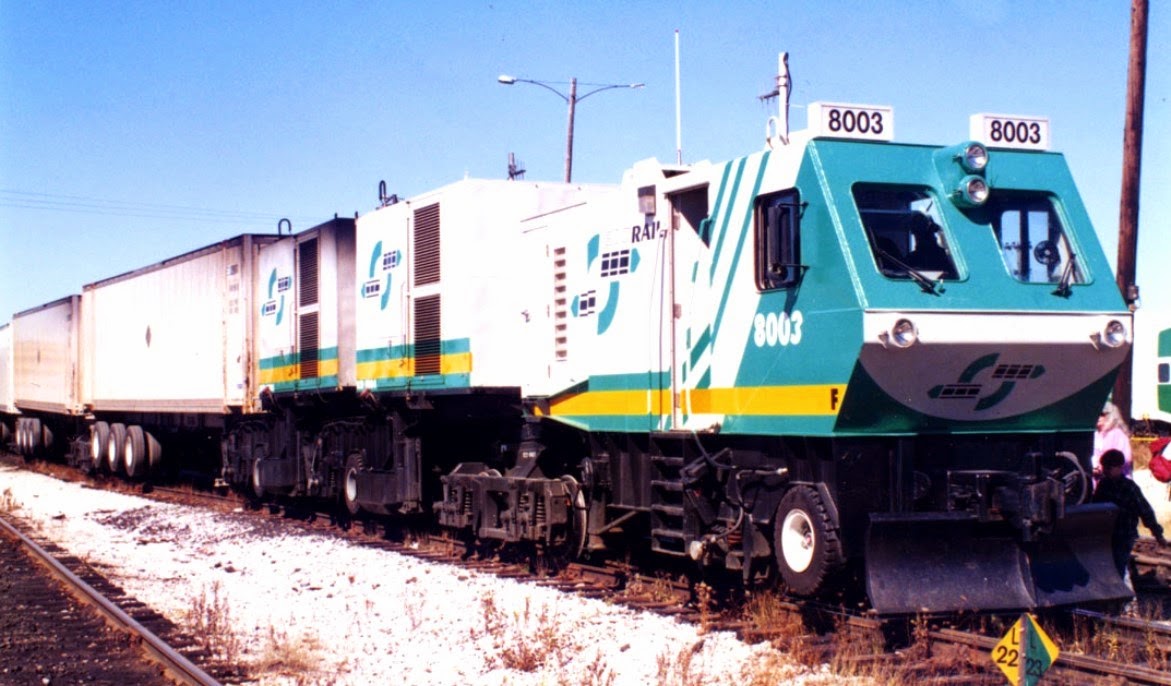 |
| CN No 308 engines 2297-8845 |
Recently, while doing some fair-weather railfanning with a cup of coffee at our nearby McDonald's, I took a series of digital photographs of CN train No 308. We rail enthusiasts often retrospectively regret not preserving commonplace elements of a given era's rail scene, and my train of thought led to a blog post depicting an average CN freight train. Simple caption information seemed uninteresting. So it occurred to me...freight train prose. Well, what is the most under-utilized style of prose that I could use? Then it dawned on me - of course, freight train haiku! My first attempt to include the locomotive numbers resulted in a Haiku faux-pas, neglecting the 5-7-5 syllable count.
CN motive power
2-2-9-7, 8-8-4
5-extra number
(practice my boy, practice)
 |
| GTW 138430 |
Saskatchewan grand
truck western grain eastward ho!
this ain't Michigan
 |
| OLNX 224028 |
O, NaOH!
UN eighteen twenty-four
a caustic cargo
 |
| GATX 75405 |
We're cookin' with gas
barbecue season beckons
burgs and dogs await
 |
| BNSF 728993 |
Huge rolling canvas
graffiti job not finished
a tagger thwarted
 |
| NS 114577 |
Utility poles
linemen climbing skyward, for
now horizontal
 |
| CNA 412732 |
Middle child short
Will I be a hi-cube soon?
On a paper route
 |
| Mid-train engine 8877 |
DPU to you
every pull involves a push
bringing up the rear
 |
| GLNX 8182 |
Albino tank car
propane mainly on the train
stands out in a crowd
 |
| AIMX 1114 |
Hauling tons of scrap
American Iron Steel
giant grey trash can
 |
| TTGX 851645 |
UP autorack
Building America scheme
graffiti says SCRAM
 |
| TTGX 160598 |
Van Horne would be proud
transcontinental travel
CP rack on track
 |
| WC 37434 |
West Fraser lumber
cheesehead from the western woods
Dairy State of mind
 |
| CABX 470563 |
Cabot carbon black
packed powdery particles
soon getting tired
 |
| CN 414204 |
Carrying the TIBS
transmitting all's well back here
last becoming first
'Arigatou' for reading this far. Seems I'm not the first to combine trains and haiku. A Trains magazine forum did just that, eventually dissolving into haiku critics, limerick lovers, and a discussion of syllable counts versus various steam engine wheel arrangements.
Running extra...
As always, I welcome your comments on this post or any other, anytime. Perhaps you'd like to get into the spirit of things and if commenting, express some or all of your comment in the form of haiku, that is a 5-7-5 syllable count. Off-colour limericks also welcome.
Speaking of humour, I just finished listening to Steve Martin's Pure Drivel. I would call it pure hilarity - I don't think I've laughed so much on the way to and from work as I did listening to Steve's at-times sarcastic narration. From the chapter "Suggested Book Topics": Visions of melancholy from a fast-moving train. Now some foreign writer is rushing to his keyboard ready to pound on it like Horowitz." From the chapter "How I Joined Mensa: The Dictionary is a perfect example of over-alphabetization with its harsh rules and every little word neatly in place. I prefer a softer, more fuzzy alphabetizing scheme that allows the mind to float free and happen over a word."
Steve really is a master of the written word, and is also known for his humorous Twitter account. Some lyrics from his classic bluegrass number Calico Train: Sorrow and strain, they can both long remain / They can take you and leave you alone and in pain / But freedom's in sight, it's a road in the night / It's lit by the light of the Calico Train.
Running extra...
As always, I welcome your comments on this post or any other, anytime. Perhaps you'd like to get into the spirit of things and if commenting, express some or all of your comment in the form of haiku, that is a 5-7-5 syllable count. Off-colour limericks also welcome.
Speaking of humour, I just finished listening to Steve Martin's Pure Drivel. I would call it pure hilarity - I don't think I've laughed so much on the way to and from work as I did listening to Steve's at-times sarcastic narration. From the chapter "Suggested Book Topics": Visions of melancholy from a fast-moving train. Now some foreign writer is rushing to his keyboard ready to pound on it like Horowitz." From the chapter "How I Joined Mensa: The Dictionary is a perfect example of over-alphabetization with its harsh rules and every little word neatly in place. I prefer a softer, more fuzzy alphabetizing scheme that allows the mind to float free and happen over a word."
Steve really is a master of the written word, and is also known for his humorous Twitter account. Some lyrics from his classic bluegrass number Calico Train: Sorrow and strain, they can both long remain / They can take you and leave you alone and in pain / But freedom's in sight, it's a road in the night / It's lit by the light of the Calico Train.

























